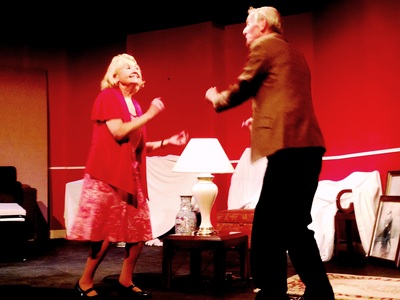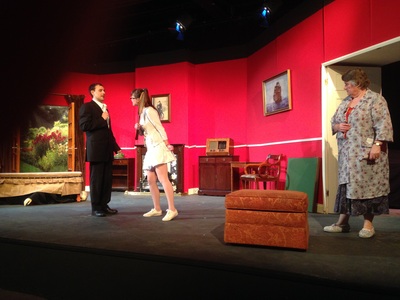
The first was The Lamp, by Melville Lovat. This new play presents a husband and wife in middle age who visit a furniture shop to look at a lamp that they have seen advertised. Owing to their indecision, they are locked in overnight. They are challenged to spend the time reviewing their past and future lives: there is plenty of scope for them, and us, to explore today’s social attitudes.
As even the two characters’ names, Doreen and Arnold, demonstrate, they are stereotypes; success depends on the authenticity of their performances. The danger is that cliché may descend into farce, and Lottie Rebello, who directs, does not entirely avoid it. Of the two actors, Mary Woolf is the more successful.
The Real Inspector Hound also has a cast of stereotypes. Even the set, an isolated manor house, is that of a typical detective fiction. The play was written quite early in Tom Stoppard’s career, but already he was highly skilled in stage technique.
As the audience can see but the cast do not, the victim of a murder is imperfectly concealed on stage, and ostensibly the play is about the long awaited arrival of the detective who will investigate. But at the start, Stoppard warns us that all is not as it seems. Two press critics are seated in a box at the side of the stage, exchanging inanities about their profession: they are to review the play that we are about to see. We soon realise that neither the identities of the characters nor their roles in the drama can be relied on. So there is plenty of scope for irony in the plot and the characterisation.
The most prominent character is Moon, one of the critics, convincingly played by Bernard Vick – well known to Belmont audiences. He turns out to mutate into various other roles. Similarly, Alan Nathan, playing Major Magnus Muldoon becomes another character who has been much spoken of. The house is owned by Cynthia Muldoon, another key character: Dawn Harvey in this role exploits a variety of opportunities. As Inspector Hound himself, Peter Tarl only appears briefly: a paradox (if it is a paradox) for which Stoppard is responsible. Even as Mrs Drudge, Helen Sherwood has to present herself originally as the charwoman and later as a sort of female butler. She has great fun with this.
And so we go on. The plot is complicated, as expected in detective dramas. The play is neither spine-chilling nor rib-tickling, as we might also have expected. Perhaps it can be summarised by saying that Stoppard builds a structure of clichés and turns it on its head, so there are plenty of ideas to keep the audience on the edge of their seats."
Review by Graham Mordue
Link to article









 RSS Feed
RSS Feed
